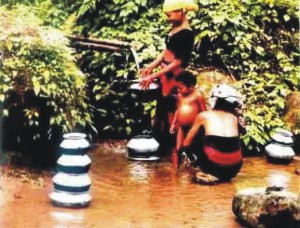5,000 indigenous people in 2 Netrakona UZs have no access to pure water
Prevalence of intestinal and water-borne diseases in the border areas round the year
Jahangir Alam, Netrakona
About 5,000 indigenous people residing in two border upazilas (UZs) of Kalmakanda and Durgapur suffer a lot due to lack of pure drinking water.Because of absence of tube-well or pond, most of the people drink contaminated water of fountains rolling down from the neighbouring India. As a result, they suffer from various intestinal and other water-borne diseases throughout the year. Different NGOs work here to improve livelihood of indigenous people but no organisation came forward to solve the scarcity of water. Tube-wells cannot be installed or ponds cannot be dug due to high land here, according to officials of leading NGOs including World Vision Bangladesh. Pure drinking water can be supplied in the area through pipes connected with deep tube-wells installed at plane land, they added. An indigenous person named Samaresh Hajong of village Ranikong in Durgapur upazila told this correspondent that during Union Parishad (UP) election, chairmen and member candidates promised a solution to water problem. After elections all of them are prone to forget the pledges. Similarly, NGOs working here to improve people's lot too expressed willingness to solve the water problem but none took any initiative in this regard, Samaresh added. Suffering people of border belt in the hillock areas urged the authorities concerned to look into the matter and address their issue as soon as possible.
|

A tribal woman collecting water from a fountain rolling down through Meghalaya in India. It is a common scene in the bordering upazilas of Durgapur and Kalmakanda. Most of the inhabitants suffer from different water-borne diseases due to the phenomenon. PHOTO: STAR |